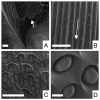The carnivorous syndrome in Nepenthes pitcher plants: current state of knowledge and potential future directions
- PMID: 21135573
- PMCID: PMC3001552
- DOI: 10.4161/psb.5.6.11238
The carnivorous syndrome in Nepenthes pitcher plants: current state of knowledge and potential future directions
Abstract
Nepenthes is the largest genus of pitcher plants, with its centre of diversity in SE Asia. The plants grow in substrates that are deficient in N and offset this deficiency by trapping animal prey, primarily arthropods. Recent research has provided new insights into the function of the pitchers, particularly with regard to prey tapping and retention. Species examined to date use combinations of wettable peristomes, wax layers and viscoelastic fluid to trap and retain prey. In many respects, this has redefined our understanding of the functioning of Nepenthes pitchers. In addition, recent research has shown that several Nepenthes species target specific groups of prey animals, or are even evolving away from a strictly carnivorous mode of operation. Future research into nutrient sequestration strategies and mechanisms of prey attraction would no doubt further enhance our knowledge of the ecology of this remarkable genus.
Figures

Similar articles
-
Contribution of pitcher fragrance and fluid viscosity to high prey diversity in a Nepenthes carnivorous plant from Borneo.J Biosci. 2008 Mar;33(1):121-36. doi: 10.1007/s12038-008-0028-5. J Biosci. 2008. PMID: 18376077
-
Fluid physico-chemical properties influence capture and diet in Nepenthes pitcher plants.Ann Bot. 2015 Mar;115(4):705-16. doi: 10.1093/aob/mcu266. Epub 2015 Feb 11. Ann Bot. 2015. PMID: 25672361 Free PMC article.
-
Evidence for alternative trapping strategies in two forms of the pitcher plant, Nepenthes rafflesiana.J Exp Bot. 2011 Jun;62(10):3683-92. doi: 10.1093/jxb/err082. Epub 2011 Mar 31. J Exp Bot. 2011. PMID: 21459766 Free PMC article.
-
The insect-trapping rim of Nepenthes pitchers: surface structure and function.Plant Signal Behav. 2009 Nov;4(11):1019-23. doi: 10.4161/psb.4.11.9664. Epub 2009 Nov 25. Plant Signal Behav. 2009. PMID: 20009546 Free PMC article. Review.
-
Traps of carnivorous pitcher plants as a habitat: composition of the fluid, biodiversity and mutualistic activities.Ann Bot. 2011 Feb;107(2):181-94. doi: 10.1093/aob/mcq238. Epub 2010 Dec 15. Ann Bot. 2011. PMID: 21159782 Free PMC article. Review.
Cited by
-
Quite a few reasons for calling carnivores 'the most wonderful plants in the world'.Ann Bot. 2012 Jan;109(1):47-64. doi: 10.1093/aob/mcr249. Epub 2011 Sep 21. Ann Bot. 2012. PMID: 21937485 Free PMC article. Review.
-
Development and regeneration ability of the wax coverage in Nepenthes alata pitchers: a cryo-SEM approach.Sci Rep. 2013 Oct 29;3:3078. doi: 10.1038/srep03078. Sci Rep. 2013. PMID: 24165663 Free PMC article.
-
Surface hydrophobicity of slippery zones in the pitchers of two Nepenthes species and a hybrid.Sci Rep. 2016 Jan 27;6:19907. doi: 10.1038/srep19907. Sci Rep. 2016. PMID: 26813707 Free PMC article.
-
Transcriptomic and Proteomic Analyses of Nepenthes ampullaria and Nepenthes rafflesiana Reveal Parental Molecular Expression in the Pitchers of Their Hybrid, Nepenthes × hookeriana.Front Plant Sci. 2021 Jan 20;11:625507. doi: 10.3389/fpls.2020.625507. eCollection 2020. Front Plant Sci. 2021. PMID: 33552113 Free PMC article.
-
Inner surface of Nepenthes slippery zone: ratchet effect of lunate cells causes anisotropic superhydrophobicity.R Soc Open Sci. 2020 Mar 25;7(3):200066. doi: 10.1098/rsos.200066. eCollection 2020 Mar. R Soc Open Sci. 2020. PMID: 32269822 Free PMC article.
References
-
- Ellison AM, Gotelli NJ. Energetics and the evolution of carnivorous plants-Darwin's ‘most wonderful plants in the world’. J Exp Bot. 2009;60:19–42. - PubMed
-
- Jebb MHP, Cheek M. A skeletal revision of Nepenthes (Nepenthaceae) Blumea. 1997;42:1–106.
-
- Clarke CM. Nepenthes of Borneo. Kota Kinabalu: Natural History Publications; 1997.
-
- Clarke CM. Nepenthes of Sumatra & Peninsular Malaysia. Kota Kinabalu: Natural History Publications; 2001.
-
- Juniper BE, Robins RJ, Joel D. The Carnivorous Plants. London: Academic Press; 1989.
Publication types
MeSH terms
LinkOut - more resources
Full Text Sources
Molecular Biology Databases
